Gordon Grice's Blog, page 90
July 17, 2011
Black bear confirmed as elder's killer
Bear confirmed as elder's killer:
"A black bear that was killed following a fatal attack June 26 on a Xaxli'p First Nations elder on her rural property north of Lillooet has been confirmed as the culprit.
DNA in the saliva found on the clothing of Bernice Evelyn Adolph, 72, matches that of the suspect animal killed July 9 by a conservation officer.
It was one of five black bears killed by conservation officers in the days following Adolph's death."
"A black bear that was killed following a fatal attack June 26 on a Xaxli'p First Nations elder on her rural property north of Lillooet has been confirmed as the culprit.
DNA in the saliva found on the clothing of Bernice Evelyn Adolph, 72, matches that of the suspect animal killed July 9 by a conservation officer.
It was one of five black bears killed by conservation officers in the days following Adolph's death."
Published on July 17, 2011 00:22
July 16, 2011
'I felt like I got hit by a truck': bear attack victim
Follow-up on one of the grizzly attack stories from last week
CTV British Columbia - 'I felt like I got hit by a truck': bear attack victim - CTV News:
"Johnny Johnson was out picking salmonberries near the remote village of Oweekeno on Rivers Inlet when he was attacked three times by the mother bear. The angry animal took a chunk of his scalp and left him with bite and claw wounds on his leg, waist and hand."
CTV British Columbia - 'I felt like I got hit by a truck': bear attack victim - CTV News:
"Johnny Johnson was out picking salmonberries near the remote village of Oweekeno on Rivers Inlet when he was attacked three times by the mother bear. The angry animal took a chunk of his scalp and left him with bite and claw wounds on his leg, waist and hand."
Published on July 16, 2011 22:23
Cheetah attacks two men

Cheetah attacks two men at Eagle Heights animal centre (From News Shopper):
The cheetah had taken quite a few bites and scratches from both the cameraman and the trainer, ripping the shorts off one in one close swipe of the paw.
The two men managed to sit on the cheetahs head while another member of staff ran for a fire extinguisher which took several more minutes to collect.
Eagle Heights owner Alan Ames, 55, told News Shopper he was surprised by the attack but says it was "no big deal".
"What happened is very unfortunate and we take it very seriously, but it's not like someone getting their arm ripped off by a gorilla."
Published on July 16, 2011 08:23
July 15, 2011
Kansas City Lightning
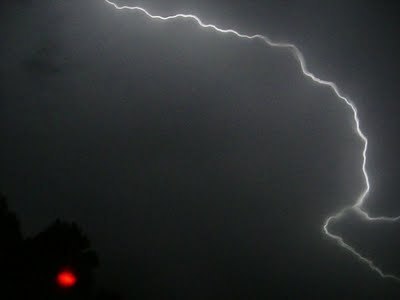
Tornadoes and sharks are scarier, but lightning kills more people--about 24 thousand a year. And ten times that number are injured by lightning each year.
Dee captured these images on a single tornadic night in Kansas City.






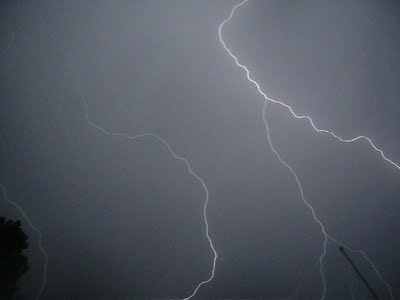
Photos by Dee Puett
Published on July 15, 2011 10:08
July 14, 2011
Massive Saltwater Crocodile

Interesting photo buzzing around the Web. Folks familiar with Photoshop say it's legit. At an estimated 18 feet, this saltwater crocodile, which leapt to a bait for the benefit of tourists in Australia's Northern Territories, would run about 3 feet short of the largest on record.
The missing leg is allegedly the result of the croc's tangle with a shark.
Published on July 14, 2011 07:32
July 13, 2011
Deathstalker Scorpions, Samsun Ants, and Saw-Scaled Vipers
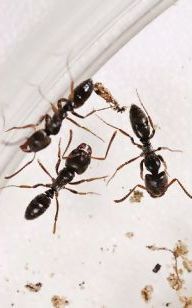
Fascinating article about dangerous wildlife of the United Arab Emirates. The UAE is home to the snake many consider the most dangerous in the world, as well as the occasional hyena or leopard, but, as the article explains, it's the half-centimeter Samsun ant that poses the biggest threat to human life.
The Samsun ant, incidentally, is sometimes smoked as a substitute for marijuana. Researchers believe its venom holds promise as an anti-inflammatory medicine.
Full: Desert survival: please do not touch the scorpions - The National:
"'People tend to think of dangerous monsters that live in the desert but what causes far more deaths are ants and stings that can cause anaphylactic shock,' says Dr Drew Gardner, a desert ecologist and zoologist, and professor of Arabian ecology at Zayed University."
Published on July 13, 2011 09:35
July 12, 2011
Jury selection begins in killer python case

Killer python: Jury selection begins in Sumter County killer python case - chicagotribune.com:
"Since 1980, the Humane Society of the United States, which opposes ownership of constrictor snakes, has documented more than 200 incidents of snake attacks, escapes, abandonments and cruelty cases in 43 states. The reptiles have been linked to the deaths of 16 people in the U.S., including seven children.
'These grim statistics include not only children who have fallen victim to the reckless behavior of others, but experienced snake handlers,' said Debbie Leahy, the organization's captive-wildlife specialist."
Published on July 12, 2011 00:48
July 11, 2011
Road Hazards of Mississippi
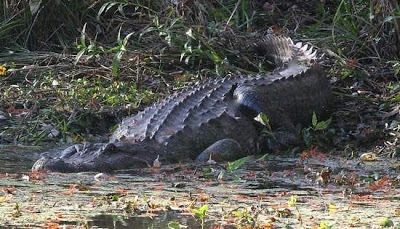
Beware of gators | rankinledger.com | The Rankin Ledger:
"'In a few instances, there have been larger alligators struck, causing damage to a vehicle,' he said.
It was near the Reservoir on the night of June 4 when Tracey Stokes said she was driving from Rankin County into Ridgeland and got a cold-blooded surprise."
Published on July 11, 2011 10:44
July 10, 2011
Grizzly roams free after fatal Yellowstone mauling
Grizzly roams free after fatal Yellowstone mauling | Reuters:
"The female grizzly bear that attacked and killed a hiker when apparently startled with two cubs will be allowed to continue roaming free in Yellowstone National Park after officials determined the animal had acted to protect its young.
A probe of Wednesday's fatal bear mauling, the first in Yellowstone since 1986, suggests the mother grizzly was provoked by a perceived threat from the hiker and his wife when they encountered the animal and its cubs foraging for food."
"The female grizzly bear that attacked and killed a hiker when apparently startled with two cubs will be allowed to continue roaming free in Yellowstone National Park after officials determined the animal had acted to protect its young.
A probe of Wednesday's fatal bear mauling, the first in Yellowstone since 1986, suggests the mother grizzly was provoked by a perceived threat from the hiker and his wife when they encountered the animal and its cubs foraging for food."
Published on July 10, 2011 10:21
July 9, 2011
An Encounter with a Fer-de-Lance
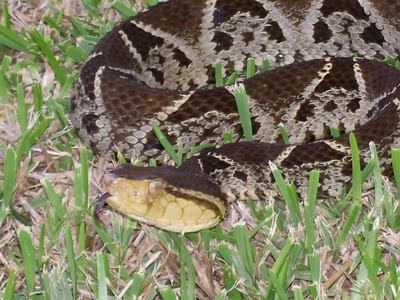
by guest writer S. C. Morgan
Costa Rica is home to many of the world's deadliest snakes, including thirteen species of pit vipers. The largest of these is the bushmaster (Lachesis muta), but it is the fer-de-lance (Bothrops asper), or terciopelo, that locals fear the most.
When we first moved to Costa Rica our neighbors repeatedly warned us about them. They believed if I merely saw a man bitten it would bring bad luck. I wasn't keen on seeking one out, but sometimes a snake is just where it is.
One February morning back in 2007 my husband and I drove to the county seat to pay our garbage bill. I dressed casually in shorts and a tank top for comfort in the tropical heat. Alan parked our old, dependable Jeep pickup in front of the municipal building and I asked if he wanted to go with me. Getting the predictable answer, I left him there and walked in. Ten minutes later, I was back. I climbed into the truck and started to tell him about my success over bureaucracy.
Then something caught my eye.
Right in front of my bare legs was a huge snake. It was sliding out of a hole where the hinges of the open door met the body of the truck, its head the size of a fat banana. At first it arrowed straight toward me, sliding its thick body over the bottom hinge of the door. Then it folded back against itself. I was sure it was about to strike. I saw the triangular shaped head. Two heat-sensing pits above its nostrils. Brown hash marks on its dark gray sides. Terciopelo.
What happened next took less than five seconds, but it felt as though the snake and I were frozen in time. Our eyes locked. My mouth tasted of metal. I remember thinking, How could there be a goddamned snake in our truck? A nanosecond later I croaked, "Snake…snake….SNAKE!"
It looked annoyed and waved about in midair. It flicked its tongue, searching for an escape. I sucked my stomach in, drawing my chest and face as far away as possible. My knees were so close I was afraid it would use them as a landing pad, and the console between the two seats blocked me from moving over into the driver's seat. I needed an exit. Now.
I jerked my legs around to get out. The snake drew back. Alan watched helplessly as it struck twice as I whipped past.
Once out, I slammed the door, hoping to crush it in the hinge. Too late. Alan saw it roll over the hinge and retreat inside the fender wall while the door closed. He estimated it was about three feet long and three inches thick. Huge.
It is amazing how much can happen in a short period of time, how fast a snake can move. Looking back, I am sure it was a warning strike. If it used all of its incredible force or extended itself fully I know I would have been snake bit.
A nurse with ER background, I had read that the average venom injected by terciopelo is about 100mg, although they can inject up to three hundred. Fifty is a fatal dose for humans. I did not know at the time— not sure it would have calmed my frayed nerves any—that adult terciopelo often save their venom when striking animals larger than they can eat, because it takes a full day to regenerate their venom. Small consolation. Terciopelo young inject the full amount, having not learned this valuable lesson yet. Pit viper venom is hemotoxic and complications with clotting factors is the number one cause of death; unless the patient is given antivenin the blood becomes more and more coagulated, the body begins to throw clots to the coronary arteries, and cardiac arrest is the final outcome.
So, there we were in Bribri with a venomous snake in our truck. Granted, it was not in the cab, at least not that we knew. Alan gingerly opened the driver's side door and popped the hood latch. Then he raised the hood. We both peered into the bowels of the motor. No snake. I kept one eye on my sandaled feet in case it wiggled out from underneath.
"I'll go get some repellent," I said, and ran across the street to buy a can of Off at the grocery store. Snakes have a strong sense of smell and I reasoned it wouldn't care for the spray. Alan opened up my side of the truck. Again, no snake. He sprayed into the dark hole and slammed the door. We waited. No snake emerged.
We discussed the anatomy of our truck. The snake must have wiggled up the wheel well– last night? Two weeks ago?– and found an entry between the exterior paneling and the inner wheel well. The only exit was how it got in, or the way it tried to get out.
"So, if we keep the door shut it can't get at us, right?" I asked.
"Unless there are snake sized holes in the firewall of the dash," Alan said.
"Great." I suddenly became acutely aware of how much rust the old Jeep had accumulated after twenty years in the tropics.
"Let's go get something to eat, " he said. "Maybe it'll leave while we have lunch." I wasn't very hungry, but I wasn't eager for an hour-long ride back home.
After hearing about our escapade, the proprietor of the little cafe kept a close watch on the truck. No snake. Customers offered up advice about how to deal with our dilemma. One suggested we spray with insecticide. I explained I'd already used mosquito repellent. "It is very dangerous to have a snake in the car," he said. The understatement for all time.
"Well, we can't stay here all night," Alan said after lunch. "I guess we'll take a chance." I was ready to leave the keys in the truck and walk away. Maybe put a sign in the window that read: Free.
The drive back was uneventful. Alan said I rode like a nine-year-old schoolgirl, sitting ramrod straight, my knees bent, and feet tucked as far away from the dash as I could get them. At one point the bead seat cover brushed the back of my calf. I almost jumped through the open window.
We never saw the snake again, but Alan did find its skin. When it left, it used a hole in the frame to peel it off. The locals tell us terciopelo are more aggressive right after they've shed their skins. The one that rode with us to Bribri was enough for me.
(Gordon's note: The terciopelo is also called the barba amarilla or tommygoff. It's one of the lanceheads, the snake genus responsible for more human deaths in the Americas than any other.)

Photos by S. C. Morgan, with special thanks to Clodomiro Picado Institute.
Published on July 09, 2011 10:17



